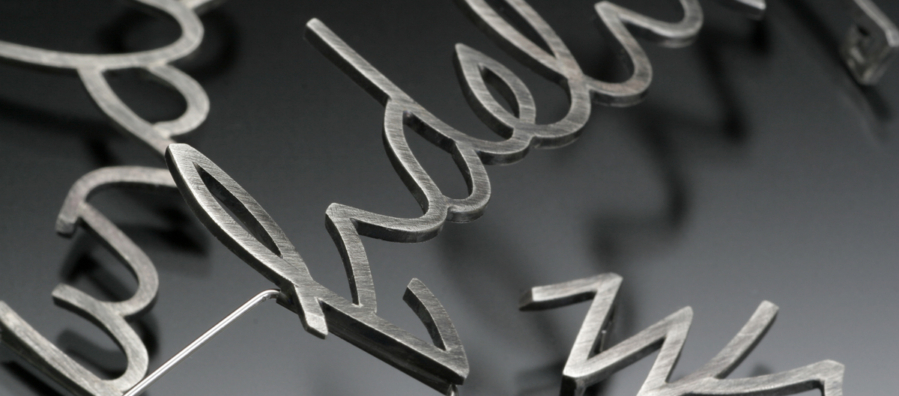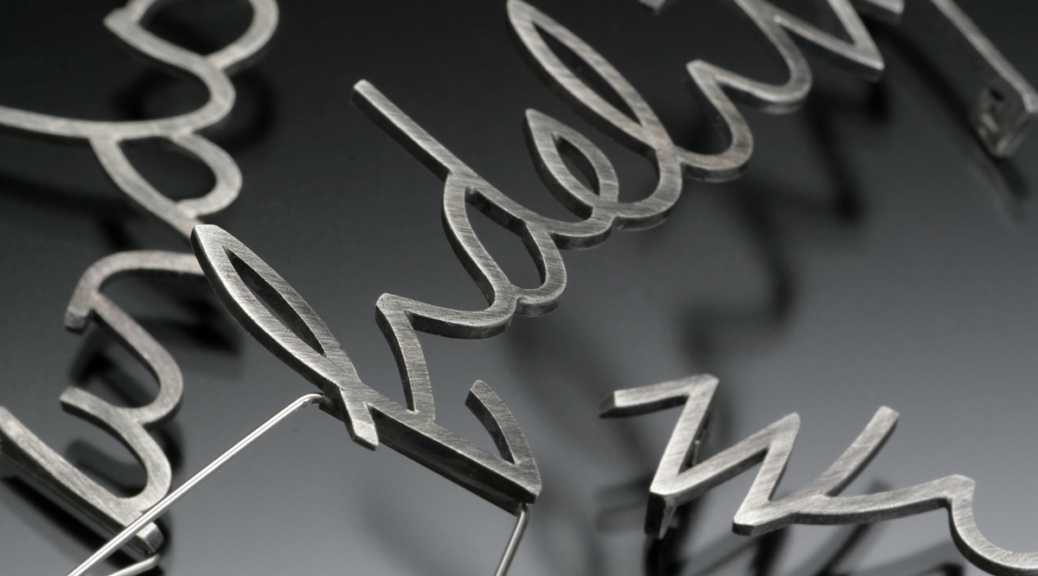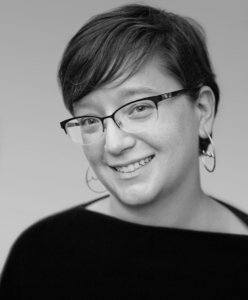
“Art jewelry is a means of communication, artist to wearer, and wearer to viewer,” says jewelry artist Trudee Hill. “Whether it is in the form of a medallion or ring, made from found objects or precious metal, jewelry has the power to send specific messages.” The emphasis on jewelry art as a means to communicate one’s thoughts and desires informs not only Hill’s work but many of the works now on view as part of the Museum’s extended exhibition, the Northwest Studio Art Jewelry Display. Trudee Hill sat down with the Tacoma Art Museum to connect and share some of the stories her work has sought to communicate.
Who are some fellow jewelry artists or artists in general who have inspired you throughout your career?
It was Sharon Church, one of my professors at the University of the Arts in Philadelphia, who truly sparked my interest in pursuing a degree in jewelry and metals. Her lectures on jewelers past and present opened my eyes to the breadth of jewelry as art throughout history. But it was her talks about how gold was formed in the cataclysmic destruction of massive stars that truly mesmerized me. That we can work with a material born of the stars, mold it and form it in order to ornament our bodies—that gold is recycled over and over and over so you know that some part of every piece you touch has been worked with by generations of artists before you—how could I not be hooked?
How did you get into jewelry making as opposed to another creative outlet like painting or sculpture?
I actually entered the BFA program at the University of the Arts in Philadelphia with the intention of studying photography. It was an elective course in metalsmithing the first semester of my freshman year which altered the trajectory of my studies and my life. The ability to design and fabricate wearable art was satisfying in a way that I had not considered possible. So absorbed in my craft, the hours would tick away in the metals studio with little notice. I considered that a sign.
However, in hindsight, I was always destined to be a Crafts major. As a child, I enjoyed making jewelry, picture frames, and wall art with embroidery thread, armature wire, beads, and shells. I also loved to sew, crochet, and knit. I even made my own backpack in the eighth grade. In high school, I took every art elective I could fit in my schedule: woodworking, ceramics, photography, drawing & painting, theater arts. I knew that I would attend an art school for university but it never occurred to me that I could major in any of the crafts disciplines. So I applied to the University of the Arts with a mixed portfolio of photography, drawing, painting, and sculpture. I feel very fortunate to have stumbled upon jewelry art so early in my studies. In the end, I only took one photography course at university. It was a portfolio documentation course that taught craft majors how to properly light and photograph their work.
What message, if any, do you hope to convey through your work?
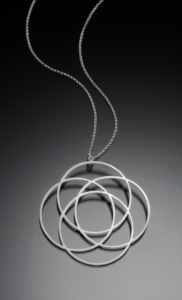
Every piece I make is imbued with my thoughts and desires. Some of my work is very straightforward: earrings that read ‘resist’ and ‘persist’ for example. While others are more suggestive: interlocking circles used to convey familial relationships. While there is a story behind everything I make, I invite the wearer to discover or, better yet, create their own significance within each piece. Jewelry is so incredibly personal. We all have a story to tell. Jewelry provides us with opportunities to connect and share those stories.
In what ways do you share your passion and engage with the community and fellow artists?
In the autumn of 2019, I moved to Cambridge, England with my partner and our two young children. We had six months to settle in before the global pandemic hit in March of 2020. Like many artists today, I am exclusively engaging with the jewelry art community online. Through email, video chat, online forums, virtual symposiums, digital subscriptions to crafts magazines—I am staying connected to the community at large as well as my mentors and friends in these strange times.
What does your creative process look like? How do you get started on a new piece? How do you know when it’s “finished?”
Though I completed all the requisite drawing classes for my BFA, these days I never sketch. A piece usually begins as an idea sparked by a conversation or something I’ve read. Over several days or weeks, I’ll think about this new piece, making and remaking it over and over in my mind. I’m often able to work out the construction of a piece in this way before ever picking up my materials. When I am ready to begin fabrication, I will finalize my design on my computer using Photoshop or Word. Then I’ll print my design in a dozen different sizes in order to determine the appropriate scale for the final piece. Only then do I sit down at my jeweler’s bench and begin working in metal. At that point, I already know in my mind’s eye how the final piece will look. All I have to do is make the piece.
In what ways do you try to challenge yourself when making new pieces?
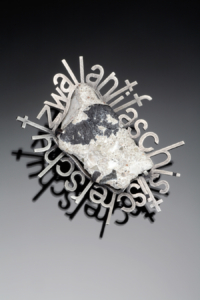
I don’t often incorporate found objects into my work, but find that when I do it provides a wonderful challenge. My piece in the permanent collection of TAM (Antifaschistischer Schutzwall Propaganda [Anti-Fascist Protective Barrier]) is a perfect example of this. I traveled to Berlin in 2006 and visited what remains of the wall. I returned home with a small concrete fragment knowing that someday I would incorporate it into a piece of jewelry. The opportunity to construct this piece presented itself in 2010 with the exhibition Celebrating 70. The show was a 70th birthday celebration for Karen Lorene, then owner of Facèré Jewelry Art Gallery in Seattle, WA. She invited 70 artists to make one piece for each of the 70 years of her life. My year was 1961, the year the German Democratic Republic constructed a wall to purportedly “protect its population from fascist conspirators” in the West. The propaganda posters of the time billed the wall as an Antifaschistischer Schutzwall which translates to “Anti-Fascist Protective Barrier.” I used this propaganda term to bisect the concrete fragment as the wall bisected East and West Berlin. Of course, we now know that the wall’s primary function was to prevent Soviet-controlled East Berliners from escaping. With Fascism on the rise today, both in the United States and around the world, this piece feels more salient than ever.
What does generosity mean to you as an artist? How do you emulate this?
I believe that kindness is the most direct manifestation of generosity. I aim to be kind in all my interactions, especially those that are difficult, and try to model this for my children daily. My greatest hope for them is that they too will strive to be kind as they move about in the world.
Is there a piece you think is most representative of who you are as an artist and the themes/stories you try to convey?
Much of my work over the past fifteen years has incorporated text in some way. The very first text-based series I made was in 2007. It was a series of five brooches and each pin was just one word: fidelity, ardor, regard, candor, and wit. This was a list of the qualities I was looking for in a prospective partner. At the time, I was single and had recently moved back to the Pacific Northwest. Online dating was still fairly new at the time but I was bold, created a profile, and proceeded to go on a number of first dates. After a while, I knew that I needed to be more direct about who I was and what I was looking for in order to find the right person. Once I had completed this series, I began to recognize these qualities in the people I was dating. Some people contained one or two, maybe even four of these qualities but I was willing to wait for the person who embodied all of these characteristics. In the winter of 2007, we met and have remained happily together to this day.
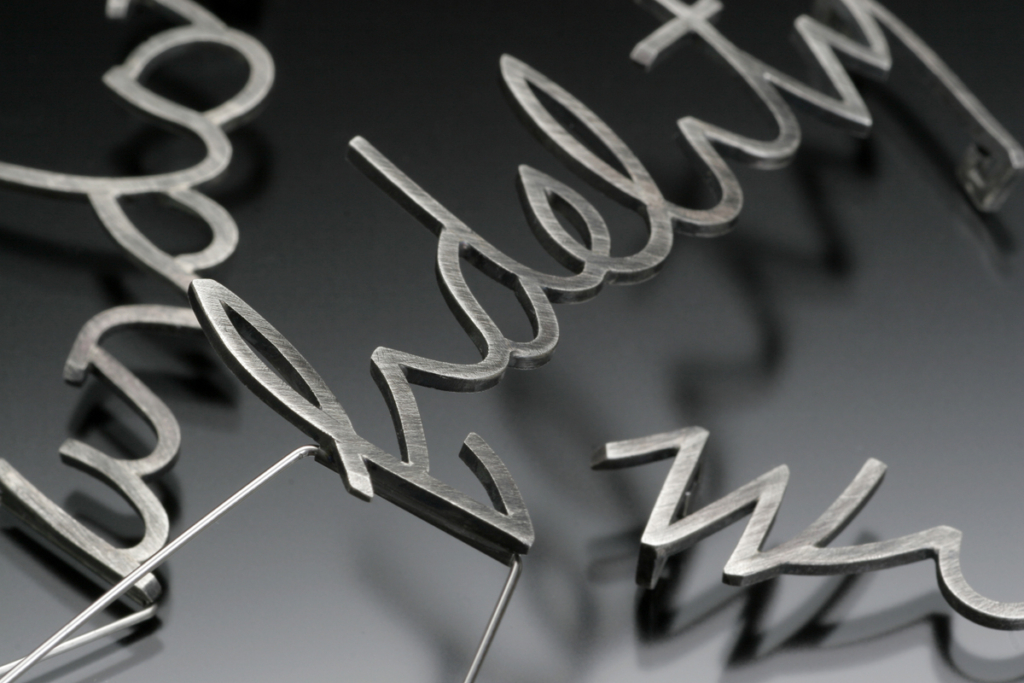
How much do you think about the person who might end up wearing your work when you’re creating something?
When I am making a piece of jewelry, I think a lot about the wearer’s comfort. I want my work to feel good on the body. I want the wearer to enjoy putting on my work, to be able to move with ease throughout their day.
Are there special challenges to working in jewelry that others might not expect?
There are many hazards in the jewelry studio: flammable gas, caustic materials, fine dust, and fumes—it is very challenging to protect one’s health while making jewelry, especially when putting a studio together on a shoestring budget. After taking a Chemical Hazards in the Arts workshop at Pratt Fine Arts Center in Seattle in 2011, I took many steps to make my studio practice as safe as possible. Then in 2012 and 2015, while pregnant with my children, I did not work in my studio at all. It wasn’t worth the risk.
Is there a work in TAM’s collection that you have a strong connection to and why (jewelry or otherwise)?
How could I choose just one?! The Studio Jewelry Collection at TAM is superb. I admire many of the jewelry artists whose work is part of TAM’s permanent collection: Ramona Solberg, Ron Ho, Laurie Hall, Cynthia Toops, Jana Brevick—I could go on. There’s no way I could narrow such an extensive list down to a single item.
What would you like to see TAM do with the jewelry collection in the future? In what ways can the Museum highlight the influence of the jewelry-making movement on art in the Pacific Northwest as a whole?
There are many studio jewelry collections in major museums around the United States: the Masterson Collection at the MFA Houston, the Schneier Collection at The Met in New York, the Farago Collection at the MFA Boston to name a few. All are extraordinary collections well worth a visit. What can TAM do to set itself apart? I recently visited the Victoria & Albert Museum in London and spent hours gawping at an exceptional collection of jewelry that spanned from 800 BCE to the present day. If TAM is to be the leading resource for art of the Pacific Northwest, where is the wearable art of indigenous people? Both historic and contemporary? I would be very interested to see a survey of Pacific Northwest Native jewelry art on display, particularly from artists associated with the Puyallup Tribe of Indians on whose homeland the Tacoma Art Museum is located.
Explore Trudee Hill’s work as part of the Northwest Studio Art Jewelry Display, now on extended view at Tacoma Art Museum. Find more of Hill’s work on eMuseum and on their website.
